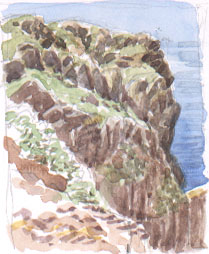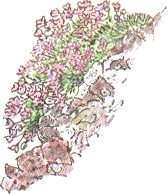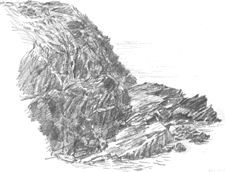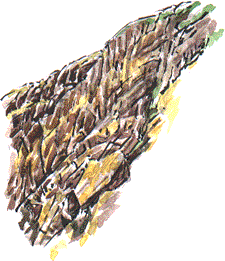Skokholm Island Diary
 
Sea Birds of Skokholm
Friday 5th
May 2000




 Nature Diary
Rocks
History
Workshop
Links
Home Page
Nature Diary
Rocks
History
Workshop
Links
Home Page



AFTER THE COOL BREEZES yesterday, today is the perfect day to sit and sketch. While the shelter was very welcome, the letterbox opening of a bird hide doesn't make it ideal as a studio. It's good to be out in the open again. I sketch the Thrift which is now in flower on the clifftop at Little Bay, to the north of the farm.
 You'd think that a small island would be the most restful of places, but I've booked in for just three days and I stride around desperate to take in all I can of my favourite places. I don't want to miss out on any of the paths, or to miss a single cove. Every indentation of the coast on Skokholm has its individual character and, over the years, birdwatchers have given almost every rock on the island its own name; the Split, Twinlet, Fossil Point, the Butterpat and so on.
You'd think that a small island would be the most restful of places, but I've booked in for just three days and I stride around desperate to take in all I can of my favourite places. I don't want to miss out on any of the paths, or to miss a single cove. Every indentation of the coast on Skokholm has its individual character and, over the years, birdwatchers have given almost every rock on the island its own name; the Split, Twinlet, Fossil Point, the Butterpat and so on.
 With all these seabirds around you'd think that I'd focus on them as subjects to sketch. But I find I need to use binoculars to take in the details and, in a way, I find that a barrier when I'm sketching. During my short stay I want to take in the atmosphere. I want to try and capture whatever it is about the island that I find so special and magical.
With all these seabirds around you'd think that I'd focus on them as subjects to sketch. But I find I need to use binoculars to take in the details and, in a way, I find that a barrier when I'm sketching. During my short stay I want to take in the atmosphere. I want to try and capture whatever it is about the island that I find so special and magical.
I find that it is the cliffs that fascinate me. I'm not the sort of artist who will use a cliff as a compositional device, I'm not interested in its abstract pictorial qualities. I wouldn't want you to see the island through my 'artistic imagination'. I'd much rather be open to whatever is special about the place and let the spirit of the island express itself through my drawings. Wouldn't it be good if I really could leave my artistic baggage (no, I don't mean my watercolours!) and my preconceptions on the mainland.
When I draw a rock I try to make it a portrait of that individual rock and I give it as much care and attention as if I was drawing the craggy face of an old friend.
These studies of the north coast of the island were made in pencil and watercolour (top left), B pencil and brush pen with watercolour wash.
Sea Birds
The Puffins are spending short periods standing outside their burrows, more time inside them, but mostly they are in groups, rafts of a hundred or more, a short distance from the shore.




I've heard people describe an Oystercatcher as 'a puffin with a carrot in its mouth'. They stand in pairs, piping anxiously, bowing their heads in a stand-off with a rival or displaying their black and white plumage in flight.
  Almost every prominent pinnacle has a Great Black-backed Gull on the look-out. This week they've been seen to raid the nests of the Lesser Black-backed Gulls on at least two occasions, to steal the eggs.
Almost every prominent pinnacle has a Great Black-backed Gull on the look-out. This week they've been seen to raid the nests of the Lesser Black-backed Gulls on at least two occasions, to steal the eggs.
  Fulmars glide about the cliffs like little grey albatrosses.
Fulmars glide about the cliffs like little grey albatrosses.
Choughs probe the clifftop turf and explode in distinctive alarm.
  Gannets fly past the island, low over the water. There is a gannetery on Grassholm a few miles further out to sea. From this distance it appears as a snowfield covering most of the rocky island.
Gannets fly past the island, low over the water. There is a gannetery on Grassholm a few miles further out to sea. From this distance it appears as a snowfield covering most of the rocky island.

 Herring Gulls tend to nest on the higher cliff ledges, above the guillemots and razorbills, or on the turf at the top. The Lesser Black-backed is more colonial and nests on the grassy tops of the cliffs. The colonies are still large but numbers have declined since my last visit to the island ten years ago. Lesser black-backs feed at sea and aren't regular scavengers at rubbish dumps like herring gulls. Perhaps changes in the way fish is processed at sea have led to the decline, or perhaps there is some other reason, a natural cycle for instance?
Herring Gulls tend to nest on the higher cliff ledges, above the guillemots and razorbills, or on the turf at the top. The Lesser Black-backed is more colonial and nests on the grassy tops of the cliffs. The colonies are still large but numbers have declined since my last visit to the island ten years ago. Lesser black-backs feed at sea and aren't regular scavengers at rubbish dumps like herring gulls. Perhaps changes in the way fish is processed at sea have led to the decline, or perhaps there is some other reason, a natural cycle for instance?
A Buzzard circles over a part of the island that reminds me of Dartmoor; open rough ground, dotted with isolated tors (islands of low rock).

Richard Bell,
wildlife illustrator
E-mail; 'richard@daelnet.co.uk'
 Next day
Previous day
Nature Diary
Wild West Yorkshire home page
Next day
Previous day
Nature Diary
Wild West Yorkshire home page

|






 You'd think that a small island would be the most restful of places, but I've booked in for just three days and I stride around desperate to take in all I can of my favourite places. I don't want to miss out on any of the paths, or to miss a single cove. Every indentation of the coast on Skokholm has its individual character and, over the years, birdwatchers have given almost every rock on the island its own name; the Split, Twinlet, Fossil Point, the Butterpat and so on.
You'd think that a small island would be the most restful of places, but I've booked in for just three days and I stride around desperate to take in all I can of my favourite places. I don't want to miss out on any of the paths, or to miss a single cove. Every indentation of the coast on Skokholm has its individual character and, over the years, birdwatchers have given almost every rock on the island its own name; the Split, Twinlet, Fossil Point, the Butterpat and so on. With all these seabirds around you'd think that I'd focus on them as subjects to sketch. But I find I need to use binoculars to take in the details and, in a way, I find that a barrier when I'm sketching. During my short stay I want to take in the atmosphere. I want to try and capture whatever it is about the island that I find so special and magical.
With all these seabirds around you'd think that I'd focus on them as subjects to sketch. But I find I need to use binoculars to take in the details and, in a way, I find that a barrier when I'm sketching. During my short stay I want to take in the atmosphere. I want to try and capture whatever it is about the island that I find so special and magical.
 Almost every prominent pinnacle has a Great Black-backed Gull on the look-out. This week they've been seen to raid the nests of the Lesser Black-backed Gulls on at least two occasions, to steal the eggs.
Almost every prominent pinnacle has a Great Black-backed Gull on the look-out. This week they've been seen to raid the nests of the Lesser Black-backed Gulls on at least two occasions, to steal the eggs.
 Fulmars glide about the cliffs like little grey albatrosses.
Fulmars glide about the cliffs like little grey albatrosses.
 Gannets fly past the island, low over the water. There is a gannetery on Grassholm a few miles further out to sea. From this distance it appears as a snowfield covering most of the rocky island.
Gannets fly past the island, low over the water. There is a gannetery on Grassholm a few miles further out to sea. From this distance it appears as a snowfield covering most of the rocky island.